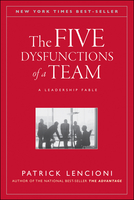The Team: A Winning Career Concept
Posted by Michelle Dempsey, Book Specialist on May 13th 2016

Teamwork. The French language has an excellent expression to describe it: esprit de corps. This means a sense of unity, a sense of enthusiasm for common interests and responsibilities, as developed among a group of persons closely associated in a task, cause, or endeavor. What about the English language?
There’s no “I” in team and there is no function in dysfunction.
There is nothing more detrimental to the success of a business, no matter how big or small, than a team that does not work cohesively for the greater good of the mission they are engaged in.
In simple, metaphorical terms? The football field. Imagine your workplace is like one of the teams playing in the next Super Bowl. And your quarterback is unhappy with what the receiver said in the locker room. And your kicker refuses to stand next to his teammate because of the way he handled press at the last playoff game. Does this team stand a chance at a ring? Didn’t think so.
Thankfully, bestselling author Patrick Lencioni also saw the benefit in strategically developing effective teams in the workplace. Following the release of The Five Dysfunctions of a Team, Lencioni engaged in facilitating a learning experience that helps professionals and their organizations discover what it takes to build a truly cohesive and effective team through The Five Behaviors of a Cohesive Team.
In the aforementioned title, The Five Dysfunctions of a Team, Lencioni uses a fictional portrayal of a CEO in the midst of a leadership crisis to drive the fable’s core message: Uniting a team in such disarray that it threatens to bring down the entire company. By portraying the tale of a leader faced with make-it-or-break-it decisions to keep a company afloat, business owners and company leaders across the world have been able to audit their own leadership behaviors, and assess whether they promote the function or dysfunction of the very teams they manage each day.
No matter which way you spin it, the essential ingredient for team functionality comes from the top: the way in which a team is led.
Thankfully, after sharing a “what not to do with your team” example, Lencioni unveils his follow-up guide to ensuring success. As part of this interactive experience, a behavioral model helps people to foster a deeper understanding of themselves and others while providing participants with feedback about their individual style and their team behaviors. Participants learn how their team scores on the key behaviors in the model—trust, conflict, commitment, accountability, and results—and use these results as a basis for conversation to create a stronger and higher functioning team.
The book specialists at Bulk Bookstore give this in-depth look into a plan for team success a strong endorsement, because we are thankful to be a part of a team well-managed. Business leaders and executives of the world, jump on the Lencioni leadership train and be part of the revolution!
Be well, read well (and go team, go!).

